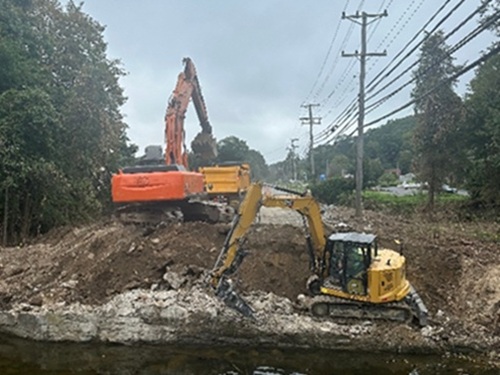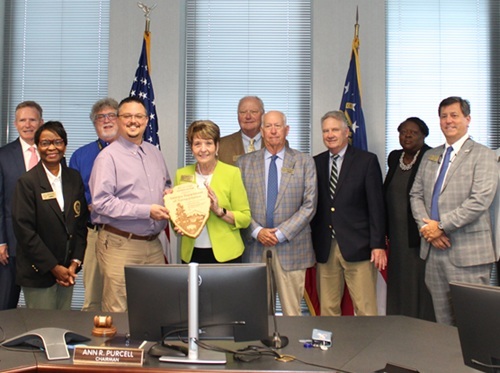The Georgia Department of Transportation recently received a plaque honoring its donation of 136 acres of land to Georgia’s Ocmulgee Mounds National Historical Park; one of the state’s most significant cultural and historical sites, according to the agency.
[Above photo by Georgia DOT]
The newly donated acreage lies within the Ocmulgee River corridor and represents land that was historically occupied and stewarded by the Muscogee or Creek people. The property, acquired by Georgia DOT in 1998 for wetland mitigation related to the Fall Line Freeway in Twiggs County, has remained undeveloped, the agency said.
The 136-acre donation supports the park’s ongoing expansion and efforts to gain designation as Georgia’s first national park and preserve, Georgia DOT noted; a transfer reflecting a collaborative effort between Georgia DOT, the National Park Service, and tribal leaders committed to honoring and protecting the ancestral lands of the Muscogee Nation.
Jacob Collins, tribal liaison with the National Park Service, presented the plaque on July 17 to State Transportation Board Chair Ann Purcell and fellow board members Cathy Williams and Tim Golden.
“This plaque [is] a small token of our deep appreciation to the Georgia DOT,” Collins said at the presentation. “This gift is more than acreage and represents the preservation of sacred ground. Ocmulgee Mounds hold profound cultural and historical significance to many tribal nations. It is a landscape shaped by generations of stewardship and a place of deep ancestral connection. Thanks to Georgia DOT, this land will now be permanently protected, interpreted, and honored as part of Ocmulgee Mounds National Historic Park.”
“It is our pleasure to help protect and preserve our history here in the state of Georgia so that the public can enjoy what was and what still is,” noted Board Chair Purcell. “I have to recognize our whole Georgia DOT family because without them this would have never happened – and it shows the interest that we have in Georgia’s historic and cultural heritage.”
Across the country, state departments of transportation are involved in a wide range of efforts to support and preserve Native American culture.
For example, the Wisconsin Department of Transportation recently helped unveil the latest set of dual-language highway signs for placement on state highways, with those signs identifying Lac du Flambeau’s Tribal boundaries and four lakes in both the Ojibwe and English languages.
“The Dual-Language Sign Program has been a big part of our ongoing efforts to help bolster Indigenous language and cultural preservation,” explained Governor Tony Evers (D) in a statement. “[This] highway sign unveiling is further testament to our work as a state to strengthen our government-to-government relationships with the Native Nations in Wisconsin.”
In April, the Washington State Ferries (WSF) – a division of the Washington State Department of Transportation – installed a pair of 10-foot-tall hand-carved Native American-themed “welcome poles” in the passenger walkway at Bainbridge Island terminal.
According to Native American lore, the poles represent the concept that “all humans may travel and have great strength to go wherever they desire and have protection and power within.” Local community members selected this artwork through a process managed by the Washington State Arts Commission in partnership with WSF.
And in September 2024, the Iowa Department of Transportation – with support from the Wisconsin DOT and the Federal Highway Administration – released a 25-minute film about the Black Hawk Bridge and that of the local communities surrounding it.
Named after Chief Black Hawk of Lansing, IA, the bridge connected Wisconsin and Iowa communities – including Native American tribes – on either side of the Mississippi River.
Created as a compliance requirement with the National Historic Preservation Act, the short film – entitled “Bridging Generations: The Story of the Black Hawk Bridge” – details the history of the 1,700-foot bridge that spans the Mississippi River, connecting Iowa Highway 9 in Lansing, IA, to Wisconsin Highway 82 in rural Crawford County.
 Archaeology
Archaeology



